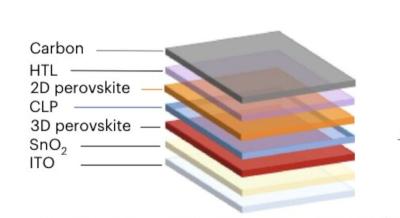Researchers at Huazhong University of Science and Technology, Wuhan University of Technology and University of Toronto recently introduced a new approach for fabricating more stable 3D/2D heterostructures, preventing their degradation. Their approach is based on the introduction of an additional layer between the structures; 3D and 2D perovskite layers.
2D and quasi-2D modified 3D perovskite heterostructures (i.e., structures comprised of 3D and 2D perovskite materials) have several advantageous qualities, such as enabling the passivation of defects and a favorable band alignment, which improve a perovskite solar cells' open-change voltage and fill factor. 3D/2D heterostructures are typically created by spin coating an organic cation salt solution on top of a 3D perovskite material and forming a thin 2D perovskite layer on its surface. This process, however, can facilitate the subsequent degradation of the heterostructures in some conditions, due to the diffusion of ions between the 2D perovskite surface and underlying bulk 3D perovskite.
"The ionic diffusion between the surface 2D and bulk 3D perovskites leads to the degradation of the 3D/2D perovskite heterostructures and limits the long-term stability of PSCs", the researchers wrote in their paper. "We incorporate a cross-linked polymer (CLP) on the top of a 3D perovskite layer and then deposit a 2D perovskite layer via a vapor-assisted two-step process to form a 3D/CLP/2D perovskite heterostructure."
Essentially, the team proposed introducing an interlayer between 3D bulk perovskites and 2D surface perovskites in 3D/2D heterostructures. This interlayer is made of a cross-linked polymer (CLP) that can inhibit ion diffusion without impacting the charge transport between the 3D and 2D perovskite layers.
"Photoluminescence spectra and thickness-profiled elemental analysis indicate that the CLP stabilizes the heterostructure by inhibiting the diffusion of cations (formamidinium, FA+ and 4-fluorophenylethylammonium, 4F-PEA+) between the 2D and 3D perovskites," the scientists explained in their paper.
To test the effectiveness of their updated 3D/2D heterostructure design, the researchers used it to create a series of small-area solar cells, as well as mini solar modules. These cells and modules attained remarkable results, as they appeared significantly more stable than perovskite-based cells and modules with conventional 3D/2D heterostructure designs.
"For devices based on carbon electrodes, we report small-area devices with an efficiency of 21.2% and mini-modules with an efficiency of 19.6%," the researchers wrote in their paper. "Devices retain 90% of initial performance after 4,390 hours operation under maximum power point tracking and one-sun illumination at elevated temperatures."
In the future, the new design could help to stabilize solar cells based on 3D/2D perovskite heterostructures, without affecting their efficiencies. In addition, the study could inspire other teams to devise similar approaches that introduce an interlayer between 3D and 2D perovskite layers to prevent degradation caused by ionic diffusion.


